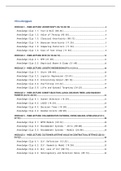Summary
Summary Customer Analytics 2022/2023 - All Lectures and Web Clips
- Course
- Institution
Summary of all the lectures and web clips for the course Customer Analytics. Not in a bullet-list type of way so you have to figure everything out yourself, but in clear, concise language. This file contains all the material discussed in the lectures and web clips.
[Show more]



